Five dinner ideas for this week
A year into the pandemic, Emily Weinstein is taking culinary inspiration wherever it comes. From supremely fast salmon to a fried breaded cutlet, here’s some quick and delicious recipes to put into your meal plan
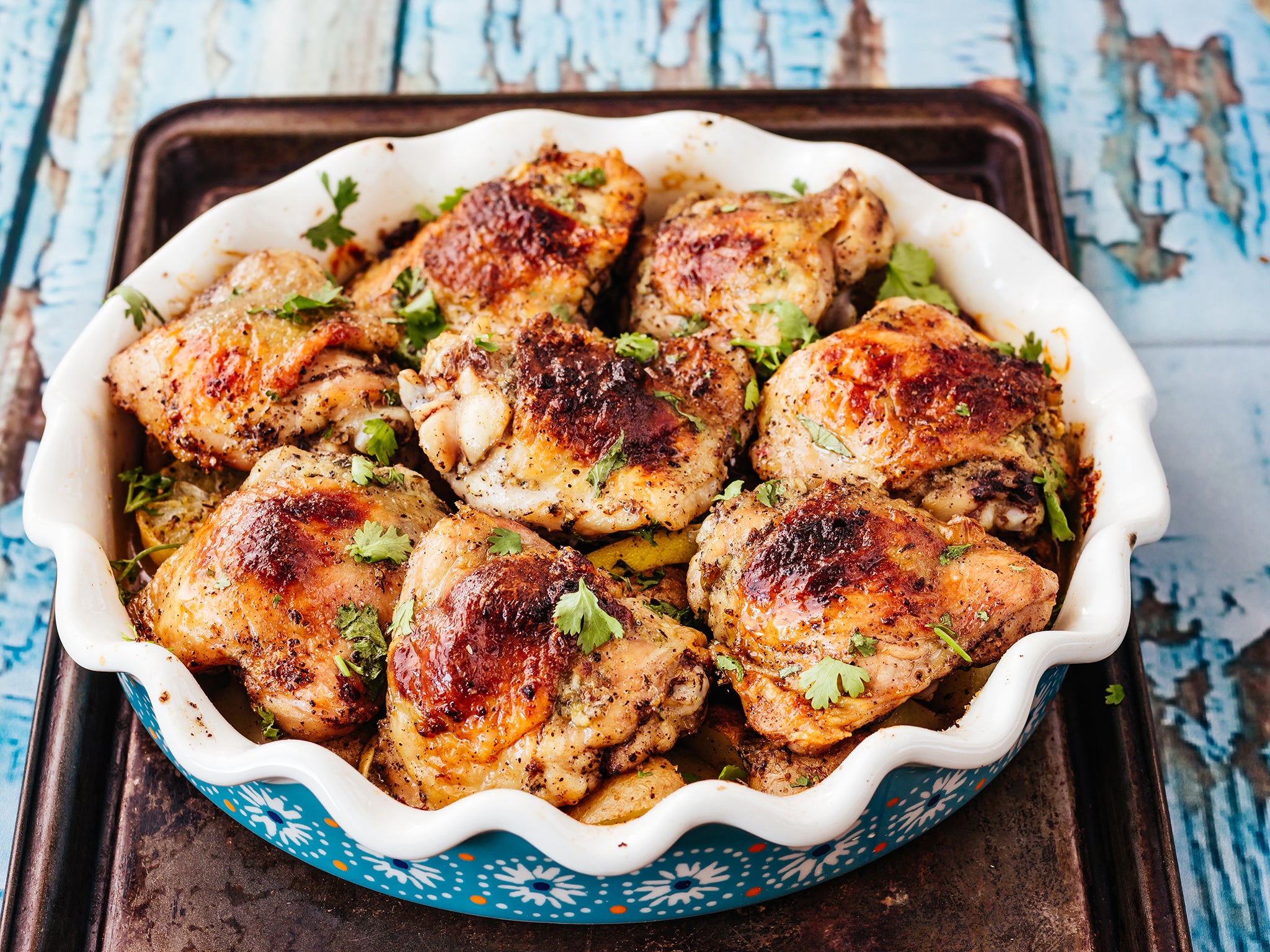
Last week, my daughter and I read Bread and Jam for Frances, the 1964 picture book about a little badger who doesn’t want to eat any of the food her mother cooks (soft-boiled eggs, toast and fresh orange juice for breakfast; breaded veal cutlets with baked potatoes for dinner). She wants only bread and jam, and so that is all her mother gives her. Frances finally breaks when the rest of the family sits down to spaghetti and meatballs.
Two thoughts: one, I wish this talented and cunning mama badger would cook for me. If someone put a freshly fried breaded cutlet down in front of me, my gratitude would be effusive to the point of embarrassing. Two, I had to make meatballs. And I did it. I made meatballs. (And red sauce too.)
Here are five dishes for the week.
Read more:
Roasted chicken thighs with cauliflower and herby yoghurt
This weeknight sheet pan meal of crispy roasted chicken thighs and cauliflower gets a flavour boost from a tangy herbed yoghurt sauce. If your cauliflower comes with leaves attached, don’t toss them. Roast them alongside the florets; just toss them with a little bit of olive oil and add them to the sheet pan about halfway through the cooking time. Make sure to scoop up a bit of yoghurt with each bite.
Recipe by: Yossy Arefi
Makes: 4 to 6 servings
Total time: 1 hour
Ingredients
1tsp ground coriander
1tsp smoked paprika
1tsp Aleppo pepper flakes (or ½ tsp red pepper flakes)
3tbsp olive oil
Kosher salt and black pepper
6 bone-in, skin-on chicken thighs (about 3 pounds)
1 small head cauliflower (about 1½ pounds), cut into 2in florets
3 shallots, quartered lengthwise
1¼ cups Greek yoghurt
2tbsp chopped fresh mint
2tbsp chopped fresh cilantro, plus more for garnish
2tbsp lemon juice, plus more for serving
1 garlic clove, finely grated
Method
1. Heat the oven to 220C and set a rack in the centre.
2. In a large bowl, whisk together the coriander, paprika and Aleppo pepper with 1tbsp oil and a big pinch of salt and pepper. Add the chicken to the bowl and toss to coat in the oil and spices. Arrange the chicken, skin-side up, on a large baking sheet.
3. Add the cauliflower, shallots, remaining 2tbsps oil, and a sprinkle of salt and pepper to the bowl. Toss to coat, then arrange the vegetables in a single layer surrounding the chicken.
4. Bake until the chicken is deep golden brown and cooked through and the cauliflower is browned, tossing the vegetables once or twice, about 40 minutes. (If the chicken is done before the cauliflower, transfer the thighs to a plate, cover, and continue cooking the cauliflower until golden brown.)
5. While the chicken bakes, prepare the yoghurt sauce: whisk the yoghurt, mint, cilantro, lemon juice and grated garlic with a pinch of salt and a few grinds of pepper. Cover and refrigerate until serving.
6. Transfer the chicken and vegetables to a platter and top with any juices left on the sheet pan and a squeeze of lemon juice. Serve with a scoop of yoghurt on the side, and fresh cilantro, if desired.
Kimchijeon (kimchi pancake)
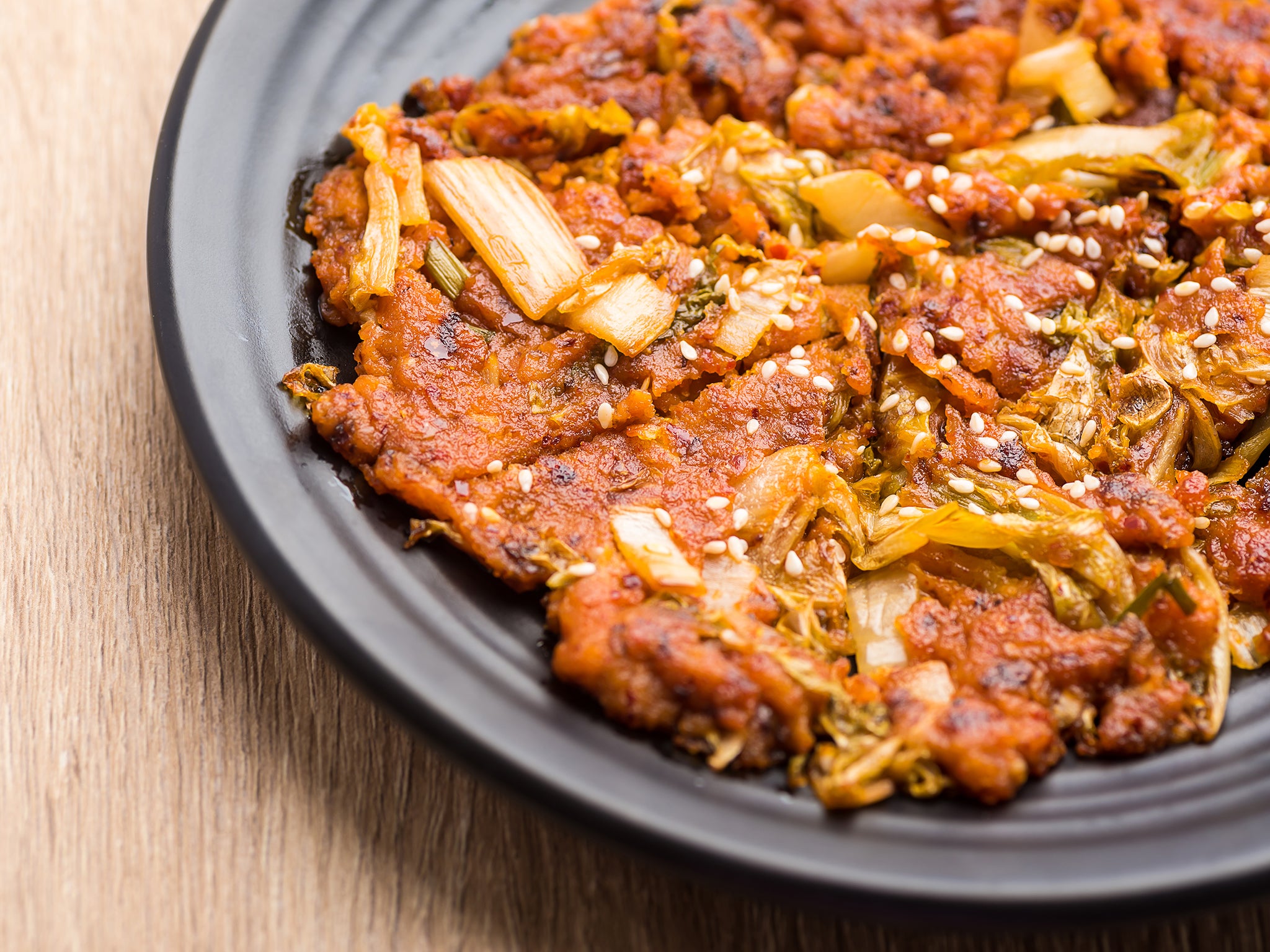
At Pyeong Chang Tofu House in Oakland, California, Young S Kim’s golden kimchijeon are a revelation. Tart with pungent kimchi, the pancakes are both satisfyingly chewy and shatteringly crisp. At the Tofu House, where Kim turns 1,400 pounds of napa cabbage into kimchi each month, her homemade kimchi is the secret to her kimchijeon’s unsurpassed flavour.
Use the most flavorful traditionally prepared kimchi you can find – it’ll make all the difference in this simple recipe. This version, adapted from Kim’s original recipe, comes together quickly: just combine kimchi and its juice with a few dry ingredients into a simple batter, then fry it in a cast-iron skillet into a mouth-watering pancake. Serve it to a crowd as an appetiser or eat it on its own as a filling meal.
Recipe by: Young S Kim
Adapted by: Samin Nosrat
Makes: 2 (25cm) pancakes
Total time: 15 minutes
Ingredients
For the dipping sauce:
¼ cup citrus ponzu sauce
1tbsp toasted white sesame seeds
1 scallion, thinly sliced
For the pancakes:
½ cup potato starch
½ cup all-purpose flour
1tsp garlic powder
½tsp baking powder
Pinch of sea salt
1 heaping cup kimchi, plus ¼ cup kimchi juice
2 scallions, chopped
2tbsp gochujang
1tbsp sugar
1tsp fish sauce
3tbsp neutral oil, such as canola
Method
1. Make the dipping sauce: in a small bowl, combine ponzu sauce, sesame seeds and scallion. Set aside.
2. Prepare the pancakes: in a large bowl, whisk together potato starch, flour, garlic powder, baking powder and salt. Set aside.
3. Dice kimchi into 1cm pieces. In a medium bowl, stir together kimchi and kimchi juice, scallions, gochujang, sugar, fish sauce and ½ cup water. Add kimchi mixture to flour mixture, and stir to combine.
4. Set a 10in cast-iron pan over medium heat. When it’s hot, add 1½ tbsps oil. When oil shimmers, add half the batter, and spread from the centre out to the edges of the pan. After about 1 minute, once you sense the pancake is setting, use a thin metal spatula to make sure the pancake is not sticking. When the bottom of the pancake is brown and the top fades from glossy to matte, after another 30 to 60 seconds, carefully flip the pancake using the metal spatula. (Alternatively, slide the pancake onto a rimless plate, and flip it back into the pan.) Continue cooking for another 60 to 90 seconds on the second side until set, then carefully slide the pancake onto a plate.
5. Use the remaining oil and batter to make a second pancake. Cut into wedges, and serve hot with dipping sauce.
Sheet-pan cajun salmon
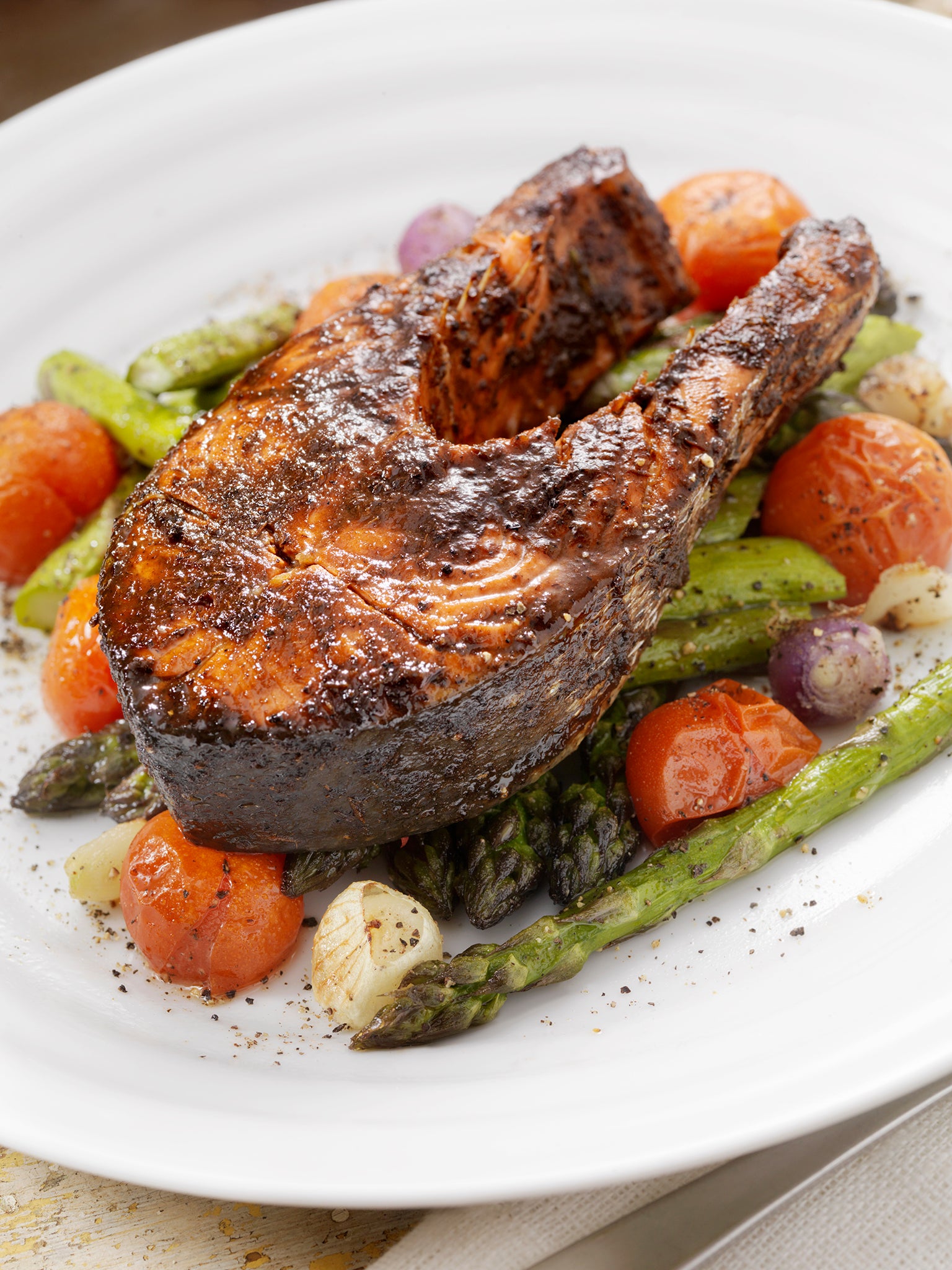
This full sheet-pan dinner, ready in 30 minutes, couldn’t be any smarter or easier. Here, salmon, potatoes and asparagus are all added to the same tray at different points for a one-pan meal that makes cleanup seamless. A marinade infused with Cajun seasoning and paprika infuses the salmon, adding smokiness and some colour. The bite in the asparagus plays off the flaky tenderness of the salmon, and the baby potatoes round it out. This meal stands on its own, but you could also put the leftovers over lettuce for a lunch salad the next day.
Recipe by: Millie Peartree
Makes: 4 servings
Total time: 30 minutes
Ingredients
4 skin-on salmon fillets, pin bones removed
4tbsp extra-virgin olive oil
1tsp Cajun seasoning
1tsp smoked paprika
Kosher salt and black pepper
450g baby potatoes
450g thick asparagus stalks, trimmed (see tip)
2 garlic cloves, chopped
Method
1. Heat oven to 220C. Place salmon on a plate, skin side up. Using a sharp knife, make a cut into the skin about 2cm deep, in 3 different places, making sure not to cut all the way through the flesh. In a medium bowl, mix 2tbsps olive oil with the Cajun seasoning, paprika and 1tsp salt. Pour over the salmon to coat it on both sides and set aside to marinate.
2. To a rimmed sheet pan, add potatoes, 1tsp olive oil, 1tsp salt, and pepper to taste. Toss to coat and roast for about 15 minutes until tender. (Larger potatoes may take longer.)
3. As potatoes roast, toss the asparagus with the garlic, the remaining 1tbsp oil, 1tsp salt, and pepper to taste.
4. Move the potatoes to one end of the pan and place salmon skin side up next to them. Add asparagus in an even layer to the other end of the pan, and roast everything together for 10 to 13 minutes, until the asparagus is tender and the salmon is cooked to taste. If you’d like the skin to be crispy, you can transfer the vegetables from the pan to a serving platter and pop the fish under the broiler for 1 to 2 minutes. Serve hot.
TIP: The thicker the asparagus, the better, as the steam from the fish can make thinner asparagus soggy.
Pork schnitzel with quick pickles
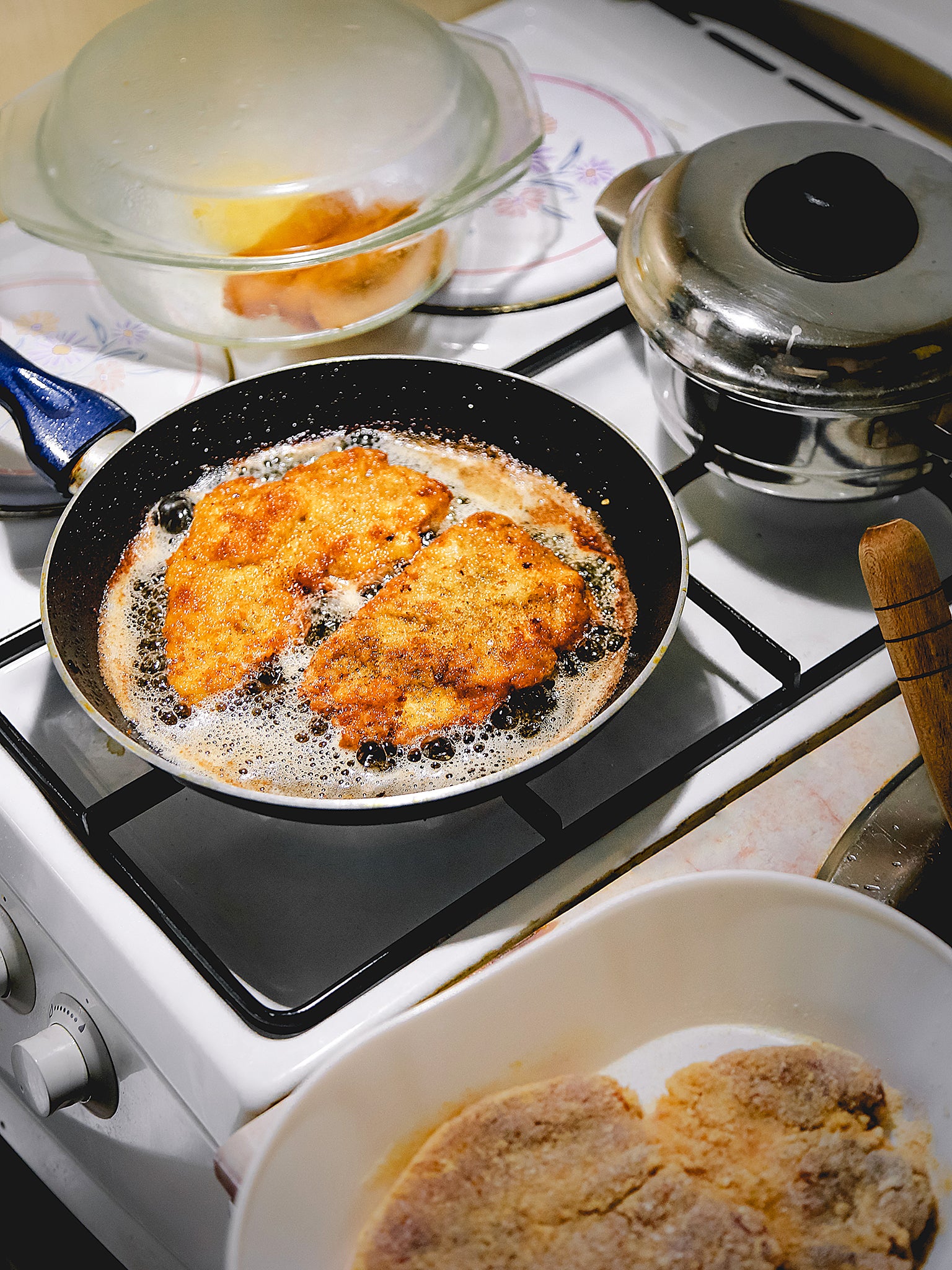
When most people think of schnitzel, they default to veal. But pork has its merits. Pork schnitzel is not only more economical than veal but also richer in flavour and easier to cook (you’ve got a bigger margin of error when it comes to timing because pork isn’t as apt to dry out).
This recipe calls for panko, which are fluffy Japanese-style breadcrumbs that make the coating particularly light. But any breadcrumbs will work. If you don’t want to make the quick pickles, serve this with a sliced up cucumber or two and/or fennel bulb with some lime wedges on the side. And if you happen to have lingonberry jam on hand, this is a great time to use it.
Recipe by: Melissa Clark
Makes: 4 servings
Total time: 30 minutes
Ingredients
For the pickles:
2 limes
3 small Kirby cucumbers or 1 large cucumber, peeled if you like and thinly sliced
1/3 cup very thinly sliced fennel bulb (save the fronds for garnish)
1 large shallot or ½ small red onion, thinly sliced
1tbsp light brown sugar
½tsp kosher salt
For the pork cutlets:
½ cup flour
1/8tsp cayenne
1/8tsp freshly grated nutmeg
2 eggs, beaten
1½ cups panko or other unseasoned breadcrumbs
680cm pounds boneless pork cutlets, pounded to 2cm thick
Coarse kosher salt and ground black pepper
Safflower, peanut or vegetable oil, for frying
1 scallion, thinly sliced, including greens
Lingonberry jam, for serving (optional)
Method
1. Prepare the pickles: Grate the zest from one of the limes and juice them both. Add zest and juice to a shallow bowl along with the remaining pickle ingredients and toss well. Let sit for at least 30 minutes and up to 3 days. Chill if letting them sit for longer than 4 hours.
2. Meanwhile, prepare the pork: mix flour with cayenne and nutmeg. Place flour mixture in one shallow dish, place eggs in a second dish, and place breadcrumbs in a third dish. Season pork cutlets generously with salt and pepper.
3. Heat oil in a large skillet over medium-high heat. While oil heats, dip cutlets one by one into flour (shake off any excess), then into eggs (ditto) and finally into the breadcrumbs, taking care not to handle pork more than necessary (hold meat by ends).
4. When the oil sizzles when a pinch of breadcrumbs is thrown in, add as many cutlets as comfortably fit in one layer, leaving plenty of room around them. Swirl and tilt pan so oil cascades over the top of the cutlet in waves. When the bottom is golden brown, 3 to 4 minutes, flip and brown the other side, swirling pan (swirling helps create air pockets, giving you lighter schnitzel). Transfer to a paper-towel-lined baking platter or baking tray and sprinkle with more salt. Repeat with remaining pork.
5. Serve pork sprinkled with scallion and drizzled with a little of the pickle juice, accompanied by the pickles and the lingonberry jam, if you like.
Olive-walnut pasta
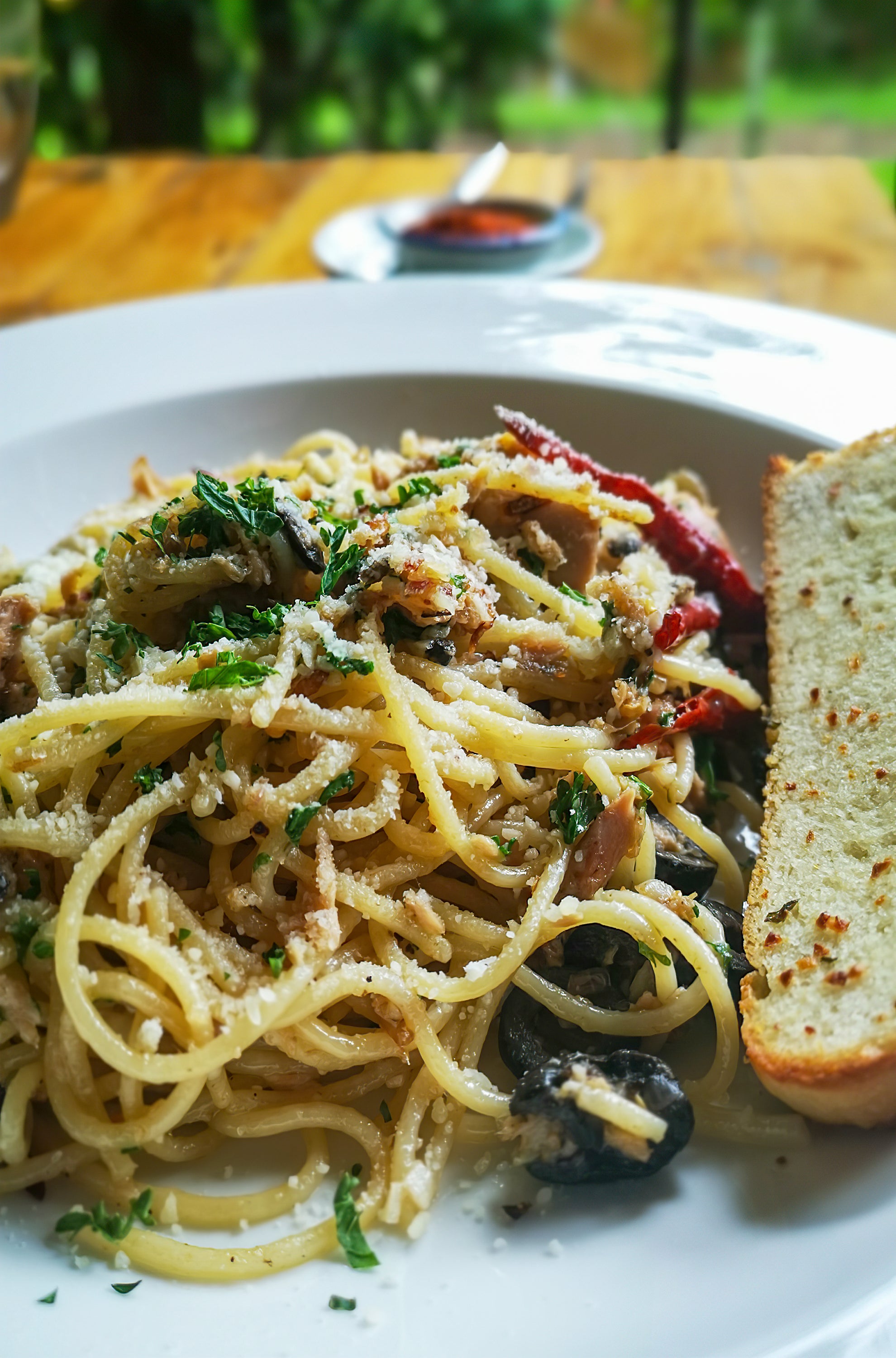
Double down on the olive oil flavour in this dish by warming a generous amount with torn green olives to dress your pasta. While you can use just one kind of olive, like mild Castelvetrano, a variety will create depth of flavour. Adding chopped walnuts provides texture and a nice dose of protein to this vegan dish, while lemon zest and juice perk everything up. It would also be good with soft herbs like oregano, dill or basil, a salty cheese like feta or parmesan, or shrimp that's been cooked with the pasta in the last few minutes of boiling.
Recipe by: Millie Peartree
Makes: 4 servings
Total time: 30 minutes
Ingredients
Kosher salt and black pepper
450g short pasta, like orecchiette, cavatelli, fusilli or elbows
½ cup extra-virgin olive oil
2 cups chopped walnuts
1¼ cups Castelvetrano olives (or a mixture of green olives), pitted and torn
1 small garlic clove, peeled
1 lemon, zested and juiced (about 3tbsp juice)
Method
1. Bring a large pot of salted water to a boil. When the water’s boiling, add the pasta and cook until al dente. Reserve 1 cup of pasta water, then drain.
2. While the pasta’s cooking, in a large Dutch oven, stir together the olive oil, walnuts and olives. Set over medium heat and cook, stirring often, until fragrant and the walnuts are toasted, 3 to 5 minutes. Turn off the heat, finely grate in the garlic clove and season with 1½tsp salt and a few grinds of black pepper. Stir to combine.
3. Add the pasta and ¼ cup pasta water to the walnut mixture. Cook over medium-low, stirring and adding pasta water as needed, until the pasta is well coated. Remove from heat and stir in half the lemon zest and all the lemon juice. Season to taste with salt and pepper and more lemon zest.
© New York Times
Join our commenting forum
Join thought-provoking conversations, follow other Independent readers and see their replies
Comments